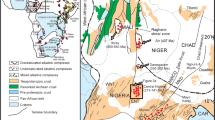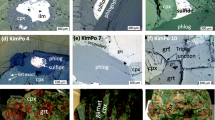Abstract.
The Bingham porphyry Cu–Au–Mo deposit, Utah, may only be world-class because of substantial contributions of sulfur and metals from mafic alkaline magma to an otherwise unremarkable calc-alkaline system. Volcanic mafic alkaline rocks in the district are enriched in Cr, Ni, and Ba as well as Cu, Au, platinum group elements (PGE), and S. The bulk of the volcanic section that is co-magmatic with ore-related porphyries is dacitic to trachytic in composition, but has inherited the geochemical signature of high Cr, Ni, and Ba from magma mixing with the mafic alkaline rocks. The volcanic section that most closely correlates in time with ore-related porphyries is very heterogeneous containing clasts of scoriaceous latite, latitic, and minette, and flows of melanephelinite, shoshonite, and olivine latite in addition to volumetrically dominant dacite/trachyte. Bingham ore-related porphyries show ample evidence of prior mixing with mafic alkaline magmas. Intrusive porphyries that have not been previously well-studied have several chemical and mineralogical indications of magma mixing. These "mixed" lithologies include the hybrid quartz monzonite porphyry, biotite porphyry, and minette dikes. Even some of the more silicic latite and monzonite porphyries retain high Cr and Ba contents indicative of mixing and contain trace amounts of sapphire (<1 mm). The heterogeneous block and ash flow deposits also contain sapphire and are permissively correlated with the intrusions based on chemical, mineralogical, and isotopic data. Magma mixing calculations suggest about 10% of the monzonitic/latitic ore-related magma may have been derived from mafic alkaline magma similar to the melanephelinite. If the original S content of the mafic magma was about 2,000–4,000 ppm, comparable with similar magmas, then the mafic magma may have been responsible for contributing more than half of the S and a significant portion of the Cu, Au, and PGE in the Bingham deposit.
Similar content being viewed by others
Author information
Authors and Affiliations
Additional information
Electronic Publication
Rights and permissions
About this article
Cite this article
Maughan, D.T., Keith, J.D., Christiansen, E.H. et al. Contributions from mafic alkaline magmas to the Bingham porphyry Cu–Au–Mo deposit, Utah, USA. Min Dep 37, 14–37 (2002). https://doi.org/10.1007/s00126-001-0228-5
Received:
Accepted:
Issue Date:
DOI: https://doi.org/10.1007/s00126-001-0228-5




